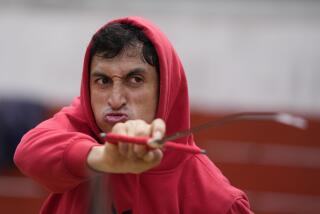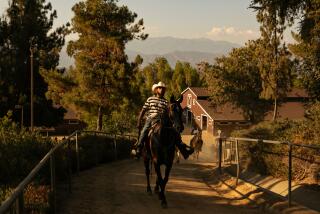THE BULLFIGHTER ‘EL GLISON’ : His Bravery Thrills Mexico Crowds, While It Is Keeping Him in Stitches
- Share via
MEXICO CITY — It would be hard for anyone unfamiliar with the cruel ways of bullfighting to understand how Jorge de Jesus Gleason, lying uncomfortably belly-down on a bullring clinic bed after a bull’s horn had perforated his backside, could be considered the star of the afternoon show in the Mexico City bullring.
Certainly it was difficult for his father, Miguel, a former abrasives salesman, to understand. The elder Gleason wandered the stadium’s corridors wondering aloud why everyone kept calling Jorge the triunfador, the victor, when, after it was all over, his son needed antibiotics and several stitches.
“They kept saying how valiant he was, how he captured the crowd,” the bullfighter’s father said. “I was just worried.”
But such is a day’s work in the short, spectacular career of “El Glison.” That’s what Gleason calls himself, so that everyone in Mexico will pronounce his Irish name correctly. And this former agricultural student, salmon fisherman and rodeo clown means for his name to be on everyone’s lips.
“I am not going to be just another bullfighter,” he said not long ago. “I’m going to be a social phenomenon.”
For the past year, Gleason has ignited crowds in Mexico like no other bullfighter, even though he is still a novillero, a rookie, not yet a full-fledged matador. No matter if sometimes his performances resemble a demolition derby.
His antics, which include jumping off a chair over the horns of a charging bull, have heightened the usual appeal of this Spanish spectacle that has been popular in Mexico for 400 years: The thrill and fascination with blood and bravery.
Whether El Glison will join the narrow, well-to-do ranks of history’s bullfighting superstars is certainly in question. Fame for Gleason, perhaps more than for any of his spangled colleagues, is running a tight race with injury.
Last fall, in his debut at Mexico City’s Plaza Mexico, the world’s largest bullring, he was gored in the rump. On his second appearance in Mexico City, he was wounded in the leg and under the armpit. In December, in Morelia, a colonial town west of Mexico City, he twisted a knee, an injury that recurred one bullfight later and forced him to cancel several year-end engagements.
For Gleason, it’s all part of his attraction.
“I appeal to the morbid sense in the audience,” he said. “I don’t care if they come to see me die, as long as they come.”
He admits that he doesn’t know how to fight bulls very well. His cape work is herky-jerky. In an event that must end with the bull’s death, his kills often exhibit more butchery than graceful efficiency.
In a profession devoted to tradition, Gleason makes his own rules. Other bullfighters wear the traditional pink stockings: El Glison wears white because he considers pink unmanly. Other bullfighters pin a little pig-tail at the back of their heads: El Glison braids his own flowing hair and ties it with a black ribbon.
Although bullfighting is perhaps the only event in Mexico, sporting or otherwise, that begins on time, El Glison has been known to show up late for his own performances. Others may use the slender sword to finish off the bull: El Glison sometimes does it with a dagger.
Words on a bullfight poster in Acapulco offer the best, short description of an afternoon with El Glison: “Genius! Or Crazy?”
The recent afternoon in Morelia was typical. As customary, to get things started, he leaped from his chair over the bull as it entered the ring. Then, swinging a big pink cape, he lured the bull past him while staring up, smiling, at the crowd.
Again in his chair, he sat waiting for another charge from the bull, now weakened by repeated stabs from the lances of mounted assistants. El Glison held two truncated banderillas, the harpoon-like weapons that bullfighters jab into the bull’s shoulders to agitate and bother it. As the bull approached, El Glison rose, as if offering the animal a seat, feinted with his hips and stuck in the banderillas.
He then worked with the little red cape behind his back, a dangerous maneuver within a razor’s breadth of the horns. The bull bumped him and knocked him down. The horns tore his shirt. At some point El Glison twisted his knee. He botched the kill with the sword and decided to dispatch the bull with a dagger to the back of the head. Unconventional, to say the least. The crowd stood and roared.
“If he wasn’t doing this, he’d probably be leading guerrillas in the hills,” his trainer and sword-carrier, Edmundo Roldan, said.
At 25, Jorge de Jesus Gleason is an old man among novice bullfighters. Most begin in their teens. Gleason embarked on his career after his income from promoting rodeos eroded under the pressure of Mexico’s devalued currency and inflation.
“I’m not really in love with the mystique of bullfighting,” he said. “I can do without all that strutting around.”
What he seems to thrive on is adventure. He has fished in Alaska, ridden bulls in Texas and Mexico, traveled around the world selling Mexican trinkets.
“In Morocco, some thieves tried to rob me at knifepoint,” he recalled. “I pulled out my own knife and we compared. They let me alone.”
Gleason began his career with another kind of bull, Brahmas, dodging them in rodeos dressed in an American football jersey and sometimes riding them as well. He once broke both forearms falling from a bull. He also played halfback and defensive back in high school in Saltillo, his hometown in northern Mexico. The contact and acrobatic drills of football helped accustom him to contact, Gleason said, adding, “I know how to relax when hit.”
But linebackers do not wear horns, and Gleason’s family would prefer that he took up a more tranquil pursuit. He married when he was still planning a career in ranching.
His wife and parents no longer attend his bullfights.
“It’s too much for me,” said his father, who saw him perform twice in Mexico City and get punctured three times.
It’s too much for some newspaper critics, too.
“His interpretation of bullfighting is a transportation to the Roman circus,” one said. “All that’s missing is the lions.”
Gleason is one of the few novices actually paid to fight; most pay the local impresarios to get into the ring, or fight for free just to get noticed. But besides the money, Gleason seems to enjoy the crowds and the acclaim. Getting knocked to the ground usually brings a wide smile, a trademark already as familiar as his mid-arena leaps from the chair. After an afternoon’s fight, he often stands for hours outside provincial bullrings signing autographs.
“El Glison does not like to be alone,” trainer Roldan said.
Even in the tender hours before he enters the ring, when the ritual dressing takes place, and El Glison slips on his tights, braids his hair, slips into his vest and prays, he likes to be surrounded by friends and music and small talk.
“It is like a sickness, a vice,” his father said. “Bullfighters must have the crowd.”
El Glison has the crowd, now, for as long as he lasts.
‘I am not going to be just another bullfighter. I’m going to be a social phenomenon.’--JORGE DE JESUS GLEASON
More to Read
Sign up for Essential California
The most important California stories and recommendations in your inbox every morning.
You may occasionally receive promotional content from the Los Angeles Times.













